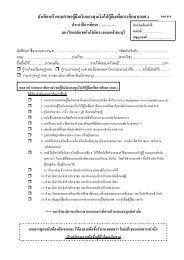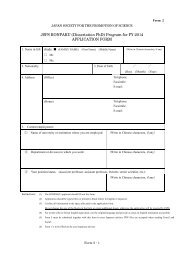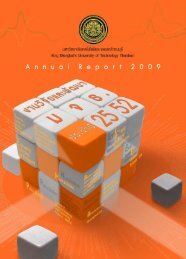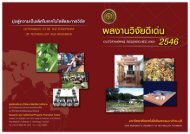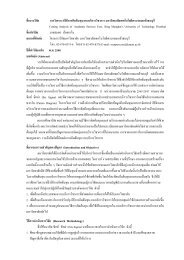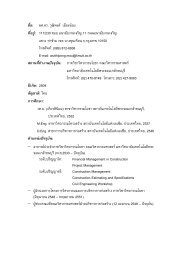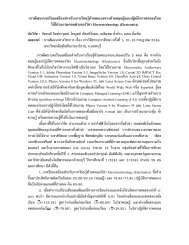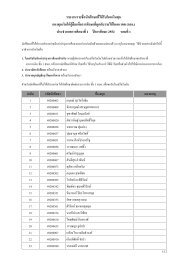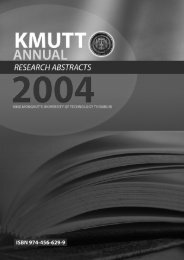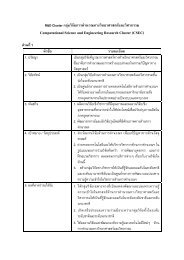You also want an ePaper? Increase the reach of your titles
YUMPU automatically turns print PDFs into web optimized ePapers that Google loves.
KMUTT Annual Research Abstracts 2005<br />
Raungrong Suleesathira<br />
2005 CACS Automatic Control Conference,<br />
November 18-19, 2005, Southern Taiwan<br />
University of Technology Tainan, Tainan,<br />
Taiwan, p. i-150<br />
An adaptive Generalized Sidelobe<br />
Canceller (GSC) beamformer is proposed for<br />
Multiple Access Interference (MAI) cancellation<br />
in the MC-CDMA receiver. In GSC<br />
beamforming, the mainbeam is formed in the<br />
look direction estimated form the MUSIC<br />
algorithm while MAI is cancelled by adaptive<br />
nulling in the unlook directions. The adaptation<br />
is to minimize the mean output power of the<br />
processor, while maintaining the unity response<br />
in the look direction based on the steepest<br />
descent method. The simulation results are given<br />
to illustrate the performance of the presented<br />
beamformer compared to the conventional MC-<br />
CDMA receiver. It is capable of reducing Bit<br />
Error Rates (BERs) of the desired user in<br />
Rayleigh fading channel.<br />
IC-043 EQUALIZER AND SUB-ARRAY<br />
BEAMFORMER FOR SPEECH<br />
ENHANCEMENT<br />
Weerawat Taweesangrungroj,<br />
Raungrong Suleesathira<br />
2005 CACS Automatic Control Conference,<br />
November 18-19, 2005, Southern Taiwan<br />
University of Technology Tainan, Tainan,<br />
Taiwan, p. i-151<br />
This paper proposes the use of<br />
equalizers and sub-array beamformers for<br />
speech enhancement to reduce echoes and<br />
interferences in room enclosure, such as<br />
conference rooms or classrooms. The method is<br />
based on a microphone array processing<br />
technique. It consists of sub-array division<br />
inverse filtering and beamforming. Sub-array<br />
technique divides a broadband signal into a<br />
spectral series of narrowband signals. Inverse<br />
filter uses for equalizing the reverberant<br />
characteristics. It is obtained by the minimumphase<br />
component of the room impulse response.<br />
The optimal beamformer has and ability to<br />
remove the interference signal. Simulation<br />
results are given to illustrate the efficiency of the<br />
proposed method in comparison to using the<br />
delay-and-sum beamforming and the optimal<br />
beamforming. The equalizer and sub-array<br />
beamformer achieve a good performance in that<br />
91<br />
the quality of captured sound is higher than<br />
those two methods.<br />
IC-044 IMAGING FM-CW RADAR SYSTEM<br />
FOR INDOOR HUMAN DETECTION<br />
Chanin Wong-ngamkam,<br />
Raungrong Suleesathira, Paisarn Keawket<br />
The 20 th Commemorative International<br />
Technical Conference on Circuits/Systems,<br />
Computers and Communications (ITC-CSCC<br />
2005), July 4-7, 2005, The Shilla Hotel, Jeju,<br />
Korea, pp. 813-814.<br />
In this paper, the use of a scanned FM-<br />
CW radar to detect human motion in building is<br />
investigated. The designed radar system consists<br />
of RF section, baseband section, data acquisition<br />
and control unit, processing and display. The RF<br />
section is to generate a radar signal having<br />
power 13 dBm at the center frequency 12.46<br />
GHz and sweep frequency 200 MHz. Mixing the<br />
reflected radar with the transmitted signal, we<br />
obtain the beat frequency. The output of the<br />
mixer is then filtered and amplified at the<br />
baseband section. In the section of acquisition<br />
and controlling, an analog-to-digital converter,<br />
an encoder, a motor and a microcontroller<br />
(89c51) are employed to interface a computer<br />
via RS232. The resulting beat frequency given<br />
by FFT in the processing section allows us to<br />
obtain the target range. After testing the<br />
accuracy of the presented radar system, the<br />
experiments are done in two cases: with and<br />
without obstacles. The radar images show the<br />
detection of the human movement using our<br />
designed FM-CW radar system.<br />
IC-045 THE ANALYSIS OF MOBILE PHONE<br />
UTILIZATION IN LAOS WITH NEURAL<br />
NETWORK<br />
Bounhap Souligno, Wuttipong Kumwilaisak,<br />
Chirasil Chayawan<br />
The 20 th Commemorative International<br />
Technical Conference on Circuits/Systems,<br />
Computers and Communications (ITC-CSCC<br />
2005), July 4-7, 2005, The Shilla Hotel, Jeju,<br />
Korea, pp. 1325-1326<br />
This paper addresses the analytical<br />
method of Mobile phone utilization in Laos<br />
People’s Democratic Republic (PDR) with<br />
neural network. In our study, several important<br />
factors are used for forecasting the growth of<br />
International Conference



